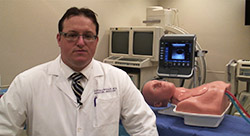
A novel central line simulation curriculum for residents designed and implemented at Feinberg is being rolled out at dozens of U.S. Department of Veterans Affairs (VA) facilities throughout the nation.
A group of medical educators led by Jeffrey Barsuk, MD ’99, GME ’02, MS ’10, associate professor in Medicine-Hospital Medicine, recently demonstrated the effectiveness of the training in reducing central line-associated bloodstream infections (CLABSI) at Chicago’s Mercy Hospital and Medical Center.
The findings were recently published in BMJ Quality and Safety.
“We have completed several studies showing how the development of these skills with real patients is inadequate,” said Barsuk, a member of the Institute for Public Health and Medicine and Simulation Technology and Immersive Learning Center. “Using traditional methods, mastery simply can’t be accomplished because residents cannot focus on purely learning, and they do not have enough opportunities to practice.”
Central lines, or central venous catheters, are often inserted into the jugular vein and are used to administer medications or fluids, obtain blood for testing and measure blood pressure near the heart.
CLABSI is a preventable illness costing hundreds of millions of dollars in annual healthcare costs. The infections are usually serious and typically result in longer hospital stays and increased risk of mortality. They can be prevented through proper insertion techniques and management of the central line.
The innovative central line simulation-based training program was first used at Northwestern University Feinberg School of Medicine in 2006. Since that time, the rate of CLABSI for central lines placed by internal medicine residents has declined to near zero.
Masters of Practice
The training relies on mastery learning and deliberate practice, a process whereby the learner uses repetitive practice on a focused task to gain competency in a skill. Training is not complete until a high level of competency is achieved on simulated procedures.
“The trainees start by obtaining consent from the ‘patient’ and ends with them letting the nurse know that the procedure is over,” Barsuk said. “Everything in between is exactly as it would be in a real setting. We practice how we play.”
Although the concept of mastery learning has been around for decades, its introduction at Feinberg marked the first time it was used in medical simulation.
Learners build their knowledge by completing the procedure from start to finish, rather than isolating different components and performing them repetitively. After observing a student, if a specific area needs more focus, the teacher may separate that task out in a later session. This is referred to as deliberate practice.
“The time it takes to achieve mastery training tends to vary for each learner, but the educational outcomes are always the same,” Barsuk said. “In the end, the technique is mastered.”
The skills checklist used to determine mastery was developed by Dr. Barsuk with an expert panel of doctors who frequently perform central line insertion. After residents complete a baseline skills assessment, they watch a video and lecture demonstrating proper procedure before engaging in focused practice using the simulator.
The simulator gives feedback on the user’s technique. For instance, if the needle being inserted hits the artery, the blood is red, and if it hits a vein, it is blue. The mannequin is also ultrasound compatible, meaning practitioners can see the needle as it is inserted.
“We rolled this out several years ago and we were able to show that by training residents, we were able to positively affect patient care in the ICU,” Barsuk said. “We reduced complications including arterial puncture, the number of times the skin was punctured and CLABSI rates. We also showed a cost savings to the hospital; a seven-to-one return on investment in one year.
That cost-saving study got the attention of Doug Beighle, president and chief operating officer of Simulab and Medical Error Reduction and Certification Inc. (MERCI).
Educational Grant
After the success of the program at Feinberg – developed with Diane Wayne, MD, vice dean of education and Dr. John Sherman Appleman Professor of Medical Education – the curriculum was acquired by MERCI.
The medical procedural training company granted Barsuk a training grant to rollout the curriculum at 63 of the 123 inpatient VA facilities across the nation. So far, the group of master trainers from Feinberg has visited five VAs, where they instruct future teachers over two days. Phase two of the grant will begin in September and cover the remaining VA hospitals.






